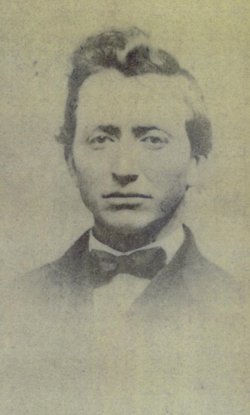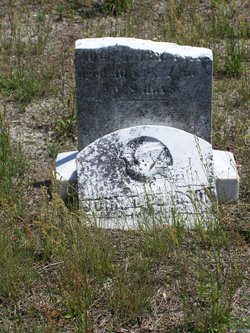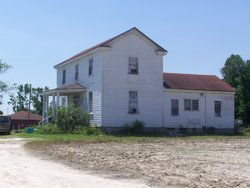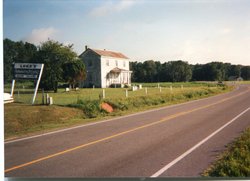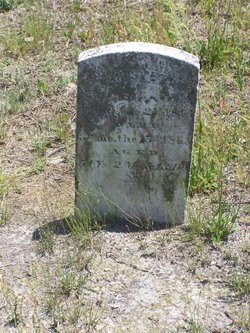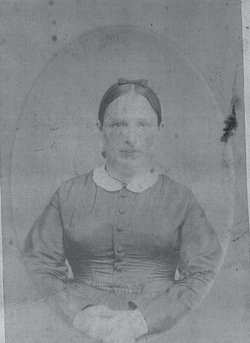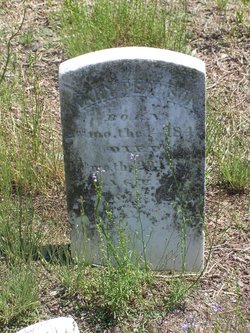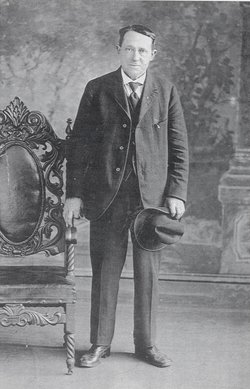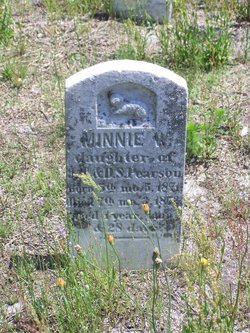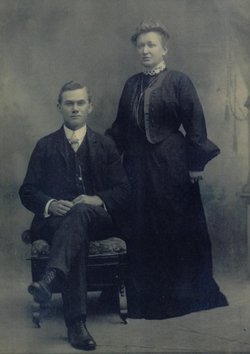| Description |
: |
Thomas and Dicena met while attending New Garden Boarding School (now Guilford College) at Greensboro, North Carolina. Their fathers, Lazarus Pearson and Joseph Newlin, were trustees of that Quaker school. After their wedding in Marlboro Friends Meeting in Randolph County, North Carolina, Dicena's native meeting, they lived on a farm near her parents at Sophia in Randolph County, where their first four children, Joseph, John, William, and Emily, were born. Thomas moved his membership from Contentnea Friends Meeting in Wayne County, North Carolina, his native meeting, to Marlboro on January 12, 1861.
Thomas and Dicena were both descended from old...
Read More
|
Thomas and Dicena met while attending New Garden Boarding School (now Guilford College) at Greensboro, North Carolina. Their fathers, Lazarus Pearson and Joseph Newlin, were trustees of that Quaker school. After their wedding in Marlboro Friends Meeting in Randolph County, North Carolina, Dicena's native meeting, they lived on a farm near her parents at Sophia in Randolph County, where their first four children, Joseph, John, William, and Emily, were born. Thomas moved his membership from Contentnea Friends Meeting in Wayne County, North Carolina, his native meeting, to Marlboro on January 12, 1861.
Thomas and Dicena were both descended from old Quaker families of North Carolina. The majority of Thomas' ancestors were among the Quakers who came directly from England to Virginia and the Albemarle area of northeastern North Carolina (Pasquotank and Perquimans Counties). Using the ferries, many of these families moved southwest before the Revolution to Wayne County, a swampy lowland area of Eastern North Carolina drained by the Neuse River, the county seat of which became Goldsboro in 1779. Only a few of Thomas' ancestors came to Wayne County from New Jersey and Pennsylvania. But it is not known where the family of his paternal grandmother, Elizabeth Bradbury Pearson, came from, for she was apparently not a Quaker and her parents are uncertain. On the other hand, nearly all, if not all, of Dicena's ancestors were among the Quaker families that came from the Philadelphia area of Pennsylvania to the North Carolina Piedmont (Alamance, Orange, Chatham, and Randolph Counties) before the American Revolution. They were of English and Scottish extraction mainly, and many settled in Ireland before moving to William Penn's Quaker colony in Pennsylvania.
According to their great-grandson, Daniel Calvin Pearson (1929-2012) of Briery, Virginia, Thomas and Dicena went to the beach at Morehead City, North Carolina when their son Joseph was one year old, as Joseph was given a toy bucket which is now a family heirloom in Mr. Pearson's possession.
Thomas and Dicena both lost their fathers in 1865, his in March, just one month before the end of the Civil War, and hers in August. As the eldest child, Thomas became administrator of his father's estate on November 23, 1865. Around this time, Thomas and Dicena moved with their children to Wayne County, where they settled on his portion of the Lazarus Pearson estate, formerly the John W. Sasser place, in Fork Township south of the Little River. Thomas established a prosperous farm and cotton gin here. His two-story home, which he probably built, was still standing in 2009 next to Luke's Auto on Route 581 in Fork Township, Wayne County. The large home of Thomas' parents, which was later inherited by his eldest son Joseph, was across the road and was also standing in 2009. These homes are on the south side of the Little River where Route 581 crosses, the bridge formerly known as the Pearson Bridge. In 1995, both homes were the only old ones standing within a neighborhood.
In 1872, Thomas also became executor of the estate of his mother, Sarah Edgerton Pearson. Thomas was the only surviving child of his parents who did not migrate to the Midwest or Southwest in the late 1800's.
Upon moving to Wayne County, Thomas and Dicena joined Contentnea Friends Meeting, also known as Nahunta, which the Pearson family had belonged to ever since Thomas' great-grandparents, Ichabod and Miriam Lamb Pearson, moved to Wayne from Perquimans County in 1776. Dicena was a very staunch Quaker. She once attended North Carolina Yearly Meeting at High Point, North Carolina with her son John. Traditionally Quakers disapproved of the use of musical instruments, believing music should come from the voice only. According to two of Dicena's granddaughters, Ella Pearson Overstreet of Newport News, Virginia and Virginia Pearson Wheeler of Lynchburg, Virginia, one of Dicena's sons gave her a piano. She struck it with a hatchet as a vindication of her Quaker beliefs. In spite of this, Dicena's eldest child Joseph, the father of Ella and Virginia who heard this story, loved music and enjoyed playing a banjo.
John Thomas Pearson came down with typhoid fever and died October 29, 1877 at the age of forty, leaving his wife Dicena and seven children between the ages of eighteen and seven months. Thomas made his will two days before his death. At that time the two oldest sons, Joseph and John, were attending New Garden Boarding School but had to quit to help their mother run the farm.
According to Thomas and Dicena's granddaughter, Ruth Pearson Harper, in "History of the Pearson Family of Wayne County, North Carolina 1700 to 1981" (1982),page 60, "Dicena lived 20 years longer and she sent each of her younger children to New Garden Boarding School for at least a year. At that time the public schools ran about three months in the winter. There the pupils learned the three R's and spelling, which was taught very thoroughly from 'The Blue Back Speller.' They could divide any long word into syllables but they didn't study phonics. ...Dicena was a short woman and probably a blonde. Anyway, her last three children had very blue eyes and honey-colored hair; the first four were all dark-haired with brown or hazel eyes. The married children lived in various houses near the family home, and she must have enjoyed having a dozen or more grandchildren around her. After her death the sons began to move away. James R. Pearson and wife Mary remained in the homestead until 1912 when they moved to a new house he had built near his brother John's close to Woodland Meeting House on the south side of Neuse River. His sister Mary stayed with them until 1902. In 1912 the homestead passed out of the family." The eldest son, Joseph, had moved to Goldsboro about 1900 and in 1911 settled with his first wife Mary and children in Prince Edward County, Virginia. The third son, Willie, moved near Salem Methodist Church in Wayne County and lived there and in Goldsboro off and on. Daughter Emily and her first husband lived in Pikeville in Wayne County. The youngest, Oliver, went to Canton, Mississippi and then to Memphis, Tennessee.
Dicena died January 24, 1897 at age sixty of pneumonia "after attending Contentnea Quarterly Meeting the previous day" (ibid). Thomas and Dicena are buried in a family plot known as the Pearson-Lewis-Gurley-Edgerton Cemetery. This is located near the intersection of Gurley Dairy Road and Capps Bridge Road in Wayne County's Fork Township, north of the Little River on the farm established by Thomas' grandfather, Ichabod Pearson, Jr., about 1831. Thomas' grandparents, parents, several siblings, and several children and grandchildren are also buried here.
The remainder of this information on the family of Thomas and Dicena Newlin Pearson is quoted from their granddaughter, Mrs. Harper, as follows, on page 61 of her Pearson genealogy:
The Pearson family has been described by one of the cousins as "poor, proud, and honest." The family record of personal integrity, good citizenship, business reliability, loyalty to the Society of Friends, and the ambition to secure the best things in life was one to be proud of. Like all Southerners, they endured the hard times after the Civil War, but they relied on their own efforts to pull through. They had, in fact, a feeling of independence and even of superiority to those whom they termed "broken-down aristocracy," the former slave owners who no longer had an advantage over other farmers because their wealth had "gone with the wind."
Because of their loyalty to Quaker principles opposing slavery and war and their very strong opposition to secession, these staunch Union men were not regarded favorably by former slave owners, Democrats, and Confederate veterans. The Pearsons were Republicans, and Lazarus was probably a member as soon as the party was organized in 1856. In eastern North Carolina most people were fiercely loyal to the Democratic Party whether they had owned slaves or not. Perhaps the Yankee raids of Sherman's Army brought on this deep hatred of all things northern. Seeing all one's worldly goods seized and sometimes wantonly destroyed in the burning house was enough to arouse extreme bitterness. The way to escape this ill will was to go West, and many did just that.
To my knowledge, Grey Garriss, grandson of Ichabod II, was the only Pearson who ever entered a political race. The Pearsons have been farmers, teachers, ministers, and small business men; many have had a considerable talent for mechanical work. Finally some lawyers, dentists, engineers, and other professionals have emerged because of excellent educational advantages. There are no farmers in the present generations.
During pioneer days the adventurous, aggressive sons felt strongly the pull of the frontier with its unlimited free, rich land. Thus for six generations many went to the Midwest while a remnant remained in Perquimans and Wayne. "Go West, young man" was a later slogan but that was the idea that appealed, and North Carolina did more than its share in populating the western states. An example is the large number of Pearsons found in the meetings in Indiana. The exception was Barney Pearson, son of Ichabod I. He migrated to Mississippi and his son, James Aaron Pearson, went on to Texas and there began a very large family. The conservatives stayed in Wayne County.
The following information on the estate and property of Thomas and Dicena is quoted from Mrs. Harper's chapter, "Men of Property," at the back of her book, pages 150-52:
After the division of Lazarus' plantation there were many exchanges of land among the children and grandchildren.
John Thomas Pearson bought 94 acres in 1870 from Elizabeth Kennedy. In 1872 he sold 103 1/2 acres to Mary Ingram which he had previously bought from the estate of Joseph Ingram. He bought one tract from William L. [Pearson] in 1874 and one from Ichabod Emory [Pearson] [Thomas' brothers] and wife, Mary Belle Moffatt, in 1877, the year of his death; no acreage was given. Mary B. Pearson's name appears on deeds 1873-77. In 1885 Emory sold John Coley all his holdings in Wayne County--548 3/4 acres--but Mary did not sign, an indication that she was deceased. About this time he moved from Bartholomew County, Indiana, to Polk County, Iowa, and later to Kansas.
The Will of John Thomas Pearson
I, John Thomas Pearson, of the County of Wayne and State of North Carolina, being of sound mind and memory, but considering the uncertainty of my earthly existence, do make and declare this my last Will and Testament in manner and form following, that is to say:
First--That my executor (hereinafter named) shall provide for my body a decent burial, suitable to the wishes of my relatives and friends, pay all funeral expenses, together with my just debts, howsoever and to whomsoever owing, out of the moneys that may first come into his hands as part and parcel of my estate.
Item: I give and devise to my beloved wife, so long as she remains my widow, all my real estate situate in the County of Wayne, State of North Carolina, and in the event of her death or remarriage, it is my will that my lands be equally divided among my children.
It is my desire that my lands lying in the County of Randolph, North Carolina, be rented out and the proceeds be applied to the improvement of the place until my daughters, Emily and Mary, shall marry or become 21 years of age; then it is my will that they shall become possessed of the same in equal proportion.
Item: It is my will and desire that one mule be sold and proceeds applied to payment of my debts; and all my household and kitchen furniture, farming utensils, stock, and the property of whatsoever kind not heretofore mentioned be given my wife and children for their use and maintenance.
Item: I hereby appoint and constitute my trusty friend W.A. Dees my lawful Executor to all intents and purposes, to execute this my last Will and Testament according to the true intent and meaning of the same, every part and clause thereof, hereby revoking all other wills and testaments by me heretofore made.
In witness whereof, I, the said John Thomas Pearson, do hereunto set my hand and seal this the twenty-seventh day of 10th month A.D. 1877.
Witness: J.F. Miller, William Perkins
Jonathan Pearson
John T. Pearson, seal
On 10-29-1877 John Thomas Pearson died just two days after making his will. Only 40 years old, he left Dicena with the care of the farm and seven minor children ranging from barely eighteen to six months.
One custom carried over from pioneer times was to have two persons swear that they had seen notices posted by the executor. In this instance E.T. Edgerton swore that he saw them at Pikeville and Fremont on 12-13-1877. Jonathan Pearson affirmed in the Quaker manner that he saw copies in Goldsboro at the Court House and at the Post Office on the same day.
William A. Dees qualified as Executor 11-21-1877. On Nov. 26 he called for all claims to be presented on or before 1-1-1878, and for debts to be paid immediately. At that time he was granted the right to sell some of the personal property for cash on 1-9-1878 because money would be more plentiful among farmers in January than in summer.
Application for the guardianship of the seven minor children was made on 12-14-1877 by Jonathan Pearson, and Letters of Guardianship were issued to him. William L. Pearson affirmed that the value of the personal property to which the minor children were entitled was $1750.00 and the value of the rents and profits was about $50.00.
From the sale of personal property held at the residence on 1-9-1878 the sum of $622.29 was realized. Some items of interest are these: one bull $8.00, one cow $10.00, one mare mule $105.00, one gray horse bought by Dicena Pearson $125.00, one colt $30.00, three hogs averaging $3.00, four bales of cotton weighing 1976 lbs. @ 10 1/16 cents brought $198.93, one log cart and fixtures $10.50, one grain thresher 10 cents, one cradle and scythe 15 cents. The last two articles went for almost nothing because machines were in use for reaping and threshing grain.
The personal property inventory of 2-12-1878 showed cash on hand 4303.00, two notes--one for $150.00 and another for $25.00--the latter considered doubtful; of accounts totalling 489.39 three out or four were doubtful as to collection.
Animals: 2 horses and 1 colt; 10 cattle, 15 sheep, 50 goats, 25 fat hogs, 30 stock hogs
Produce: 150 bbls. corn, 3500 lbs. fodder, 8 bu. oats, 100 bushels sweet potatoes, 2 stacks hay, 15 bales of cotton, 6 stands of bees
Machinery: 1 log carriage, 1 horse cart, 1 two-horse wagon, 1 buggy, 1 carriage and harness, 1 mower and reaper, 1 horse rake, 7 plows, blacksmith's tools, 1 threshing machine, 1 main wheel of cotton gin
Lumber: 4,000 shingles, 2,000 ft. of lumber
Household furniture: 1 washing machine, 1 sewing machine, 1 spinning wheel, 1 cook stove, 1 press, 19 chairs, 1 bureau, 5 double beds and single bed with feather beds, pillows, and covering, 1 lounge, 1 bookcase and books, assorted pots and pans, dishes, glasses, cutlery, etc.
Notice the new household items: washing machine and sewing machine (both manually operated), cook stove, lounge, horse-drawn mower, reaper, and threshing machine. The press was either a device for squeezing more lard from the cracklings at hog-killing time or a press for making cider from the crop of apples; some cider was always turned into fine vinegar.
Sixteen bales of cotton were sold to the highest bidder on 5-8-1878 after being duly advertised. Terms were six months credit with interest. Five bales, 2318 lbs. @ $9.25 3/4 per cwt. Five bales, 2317 lbs. @ $10.00 per cwt. The other six bales brought from $8.50 to $9.10 1/2 per cwt.; the total of 7399 lbs. brought only $690.06.
William A. Dees reported 1-1-1879 that he had received $7.50 and had paid out $1676.78 to 21 persons.
Guardianships: Jonathan Pearson was guardian for Emily and Mary Pearson in charge of all matters relating to the land of John T. Pearson in Randolph County until they reached the age of 21 or married. Then this property was to be divided equally between them.
Mary received $591.88 in 1878 and the amount increased a little each year. In 1895 her final payment was 1138.81, and her total was $14,844.32, an average of $914.37 per year.
Emily's total of $6098.40 averaged $609.84. She married in 1887 and her final payment 3-2-1887 was $843.31.
Their share of the inventory of personal property was $252.74 each.
Jonathan Pearson was also guardian for the five sons. Each began with $242.74 yearly and received payments until he reached his majority.
Joseph L. Pearson received three payments, a total of $789.46
John N. Pearson received five payments, a total of $1391.92.
William E. Pearson received eight payments, a total of $2302.19.
James R. Pearson received 14 payments until 1889, a total of $4771.41
T. Oliver Pearson received 18 payments from 1878 until he reached 18 in 1894. His total was $6999.86 and the yearly average was $388.81.
Dicena S. Pearson died in January 1897. Then the John T. Pearson land was divided among the seven children by commissioners appointed by the Court. They filed their report 4-22-1897.
After Dicena's death in 1897 a petition for division of land was filed by Nathan T. Pearson and Elizabeth F. Pearson and the seven brothers and sisters. Oliver, whose guardian, Jonathan Pearson, was now deceased, sued by his friend, J.A. Washington.
Nathan, Elizabeth, and John Thomas Pearson were tenants in common at the time of John T.'s death of Lot No. 6, 119 acres, in the division of the lands of Lazarus Pearson. Nathan's part was 1/42, Elizabeth's 8/42, and John T.'s part was 33/42. John T.'s was devised to Dicena S. Pearson for her lifetime and then should be equally divided among the children. The commissioners made the division, alloting 23 5/8 acres to Nathan and Elizabeth and 86 5/8 to John T.'s children. This tract was therefore included in the final division of 1897. The acreage was 278.35 acres plus 86 5/8 from lot no. 6. Cash payments equalized the amounts.
1. William E. 29 3/4 acres--value $595.00
2. James R. 15 7/8 acres--value $585.00
3. Oliver 27, 7 in one tract, 36 5/8 in another--value $729.00
4. Emily Pearson Smith 41 3/4 acres--value $495.00
5. Mary 41 3/4 acres--value $412.36
6. Joseph 21 in one tract and 36 5/8 in another--value $655.00
7. John 32.5 acres--value $655.00
Jonathan Pearson, brother of Lazarus Pearson, invested the funds of the minor heirs. Here is an account of how he handled one loan. He entered suit against George L. Kirby and wife, Mary C. Kirby, 9-23-1890; he asked for judgement against the defendants. Money belonging to the minor heirs had been loaned to George Kirby to buy land located on Howell's Swamp. The amount was $1085.00 for which the Kirbys gave a mortgage on three tracts of land including more than 100 acres.
W.C. Monroe, a Goldsboro attorney, was appointed referee. The case was set for a hearing in his office on 1-14-1891. Jonathan Pearson demanded judgement and foreclosure of the mortgage because the Kirbys had failed to make the last payment of $137.56. The rate of interest was then 8 percent.
The defendants objected to 8 percent compounded. In the hearing it came out that H.F. Grainger arranged the loan of the funds and informed Jonathan later of the arrangements. So there was a disagreement about the matter of the compound interest; also there had been no agreement as to the rate of interest after the maturity of the note.
It was decided the defendant should pay $137.56 with interest from 1-1-1891. If he were in default after 30 days, the plaintiff could have the land sold to satisfy the judgment and costs. Exhibit A showed all the amounts paid with interest from the year 1879.
In case of default Jonathan Pearson had the right to sell the land under mortgage at the Court House door in Goldsboro after advertising the sale for four weeks in "The Goldsboro Argus" and in public places. The plaintiff also had the right to purchase the land at the auction; from the proceeds he must pay off the heirs.
The matter was settled amicably and the mortgage was not foreclosed.
By 1902 the Pearson family was dispersed, only James R. remaining at the homestead. In late 1912 he moved to a newly-built home near his brother John at Woodland. Not a Pearson was left on the plantation of Lazarus Pearson.
*******************************************************************************
This is something I, Bryan Scott Godfrey, great-great-grandson of J. Thomas Pearson, was surprised to find online in 2011, since the above information did not mention any political service:
Wayne County, NC - Obituary of J.T. Pearson, 1877
~~~~~~~~~~
Goldsboro Messenger, Monday Oct 29, 1877
Mr. J.T. Pearson died in Fork Township, Wayne County, NC at 5 o'clock
this morning. Mr. Pearson had served in the Legislature and was for
many years an active leader in the Republican Party in this county.
|

